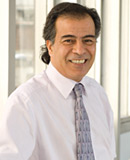Professor of radiology
Director of the Center for Molecular Imaging
Most recent post: University of Manchester
 Jamal Zweit, Ph.D., D.Sc., came to campus last July to continue his work that combines different imaging techniques to give a more comprehensive picture of what’s happening in the body. With expertise in positron emission tomography and biomarker developments, Zweit’s specialty is called multimodality molecular imaging. He also develops novel markers – everything from labeled drugs to radioquantum dots, the nanoscale probes that combine fluorescence and PET-imaging signals to selectively target molecules of interest.
Jamal Zweit, Ph.D., D.Sc., came to campus last July to continue his work that combines different imaging techniques to give a more comprehensive picture of what’s happening in the body. With expertise in positron emission tomography and biomarker developments, Zweit’s specialty is called multimodality molecular imaging. He also develops novel markers – everything from labeled drugs to radioquantum dots, the nanoscale probes that combine fluorescence and PET-imaging signals to selectively target molecules of interest.
Zweit applies this arsenal of skills to problems of cancer, from the biological pathways involved to how the disease progresses or gets interrupted with therapy. His group was the first to use molecular imaging to examine treatments that block the growth of blood vessels in tumors. With PET, they watched a biologic drug penetrate targeted tissue and then used MRI to track the effects of the drug on blood flow.
Zweit studied radiation biophysics and biochemistry as an undergraduate at the University of Kansas and nuclear medicine and molecular imaging in his graduate studies at the University of Manchester in the United Kingdom. After postdoctoral fellowships, he established a radiopharmaceutical research group at the Institute for Cancer Research in London before being recruited back to Manchester as an assistant professor to set up the Manchester PET Research Center.
Recruited by several universities in North America, Zweit chose VCU. “I saw a very good research environment here,” he says.
He’ll use the opportunity to build an internationally renowned molecular imaging center – “something that will compete with the big boys, if you like,” he says. “This is a very multidisciplinary and complex field of research that requires people from different specialties.”
Zweit is already taking advantage of the Massey Cancer Center, the larger medical center and the “excellent basic science departments” to build a critical mass of expertise.
By Jill U. Adams, for the Dean’s Discovery Report

